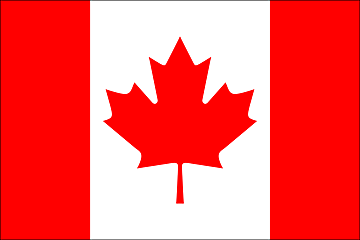A History of the Western Hemisphere Pt. 1
 •
by
•
by Alexander C Kraynor
Part I: Canadian History

The Canadian Flag
The USA-Canadian War
In its early days, Canada chose to adhere to an isolationist foreign policy that looked better than it actually turned out to be. One of the first wars in the New World was the USA-Canada War, commonly known as the War of Nave’s Toe. The USA did not see its neighbor as being a threat early on, and so war was formally declared on Canada on April 11, 2008. Canada was forced to abandon its isolationist policy and take part in a mutual protection pact with Romania in order to secure its sovereignty. At first, the USA did have an advantage and it took many regions on the first day. These territories were later regained by a Canada bolstered by foreign fighters trying to seek fame after a short ceasefire. At this point in the war the USA only held one last Canadian province, Manitoba. With the aid of foreign states, Canada then reclaimed this territory.
Regardless of the USA’s great military might, no side had a significant upper hand even after two weeks of fierce battle. The presidents of Canada and the USA, Faltnor and Nave Saikilah respectively, had been making unreasonable demands of the other side, and it seemed that the war would be interminable. But on the day after the battle for Manitoba, they were joined together by a Canadian middle-man, John Wilkmot, who helped the two parties reach an agreement. The final terms included an end to the war in conjunction with a non-aggression pact that was to span three months time. As it later turned out, Nave had also agreed to forfeit 100 Gold to the Canadians under the pre-condition that no one else would know about it. The Canadian president agreed, and then proceeded to tell another Canadian by the name of Derick Braham which ultimately led to this secret agreement becoming general knowledge.
A New Friendship
Seeing the flaws in their isolationist foreign policy, Canada had recognized the gross importance of military alliances in the New World. Canada proceeded to join the now antiquated Mediterranean Alliances and engaged in mutual protection pacts with every nation that bordered it. As time passed by, the Atlantis Alliance emerged as a reaction to the Peace Global Community, and Canada joined. Just as this alliance was created, it was put to the test. Romania, an ally of Canada in the USA-Canada War, declared war against Hungary – this war quickly escalated into one of the largest wars in eRepublik’s history since the two largest alliances up to that time found themselves at odds for the first time.
Then came the Nova Scotia War, or Great War of 2009, which can be attributed to the perceived aggression of Hungary against Canada. Hungary had negotiated a series of supposed training wars in Scotland. The Canadians quickly realized that these training wars would open a path by which Hungary could enter North America. Two months passed as every party watched and waited patiently for the other to make a move. To retain the element of surprise, France instead opened the war with Canada by attacking Nova Scotia. The Russians quickly joined in and attacked Alaska pinning America and Canada between Peace forces. Once Nova Scotia fell, the French attacked Prince Edward Island and captured it. The Canadians determined that Russia was a greater long term threat if they managed to gain a foothold in North America, and so the focus was placed on keeping the Russians out. The result of this maneuver was the temporary loss of the Prince Edward Island, but the French were beaten back as the USA attacked French-occupied Nova Scotia.
A One of a Kind Bromance
When Atlantis broke up, the Fortis Alliance was proposed to include: the USA, Canada, Spain, Ireland, and the UK. The American congress was the only legislature to ratify the charter, but US-Canadian relations remained strong because of their cooperation against the outside threat. Then came the bromance. Written by eRepublik legend Emerick, The Brolliance was formally declared between Gaius Julius, the president of the USA, and Jacobi, the president of Canada. It remains in effect to this day.
In August of 2009, Canada became the first non-European member of the EDEN alliance, and has since become a staunch ally of the eUSA.
Part I of III in the series A History of the Western Hemisphere.
For the Republik,
-Alexander C Kraynor
Secretary of Communications, BMP


Comments
My love for my Canadian bros trumps all
Thanks, Bros.
Canada and US...what a team!!!
I <3 eCanada